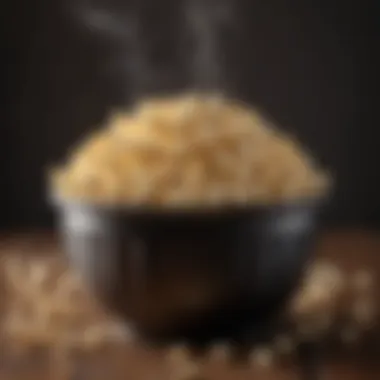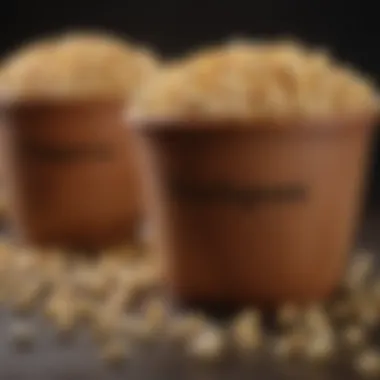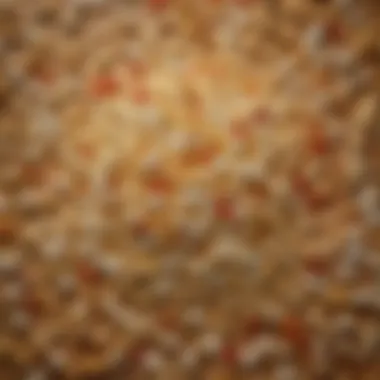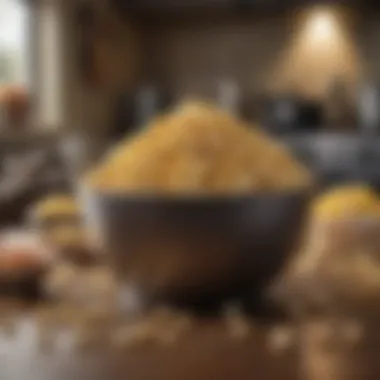Ultimate Guide to Choosing the Best Popcorn Pot


Intro
Selecting the best popcorn pot involves understanding various factors that contribute to perfect popcorn. This guide will help navigate through essential features, materials, and cooking techniques. Making popcorn is not only about the kernels; the pot you choose plays a critical role in achieving that ideal puff and flavor.
Throughout this article, we will examine different types of popcorn pots. We will discuss their benefits, user considerations, and maintenance practices to help you make informed decisions. Whether you are a beginner or someone with a wealth of experience in the kitchen, this guide aims to enrich your popcorn-making journey.
Understanding the nuances of popcorn pots is essential. Knowledge of materials like stainless steel, aluminum, or seasoned cast iron can change your cooking experience. Learning about heat distribution, pot size, and design will enhance your ability to create delicious results.
As we move forward, we will also consider alternative methods and accessories that can improve popcorn preparation, making it enjoyable and efficient. Enjoying popcorn is more than just eating; it’s about the experience of preparing it yourself, and having the right tools can significantly enhance that experience.
Preface to Popcorn Pots
Choosing the right popcorn pot can significantly affect your popcorn-making experience. A good pot not only improves popping efficiency but also ensures an enjoyable outcome. Hence, it is essential to understand the various aspects that contribute to selecting the ideal popcorn pot.
Understanding Popcorn
Popcorn is a unique variety of corn that, when heated, bursts into a fluffy snack. This phenomenon occurs due to the moisture inside the kernel. The right pot will facilitate this process, making it critical for any popcorn lover to invest in a high-quality item.
Many people do not realize that not all pots are equally effective for making popcorn. Factors such as material, size, and heat distribution play vital roles in achieving the perfect batch. This understanding is the first step toward enhancing the overall popcorn-making experience.
History of Popcorn Preparation
The history of popcorn preparation is rich and varied. Popcorn dates back thousands of years, with origins in the Americas. Indigenous peoples first discovered that certain types of corn would pop when heated. Over the years, popcorn has evolved, with various methods of preparation developing alongside it. From traditional stovetop methods to the invention of popcorn machines, the way popcorn is made continues to change.
This journey reflects cultural adaptations and technological advancements. Understanding these historical contexts enables modern enthusiasts to appreciate the snacks they enjoy even further. In addition, knowing the evolution of popcorn preparation informs better choices when it comes to selecting a popcorn pot.
Attributes of an Ideal Popcorn Pot
Choosing the right popcorn pot enhances the overall popcorn-making experience. Various attributes ensure that the pot can efficiently pop kernels to perfection while being user-friendly and durable. When selecting a popcorn pot, one should consider material, size, heat distribution, and control.
Material Considerations
The material of a popcorn pot significantly impacts its performance and longevity. Several materials are commonly used, including stainless steel, aluminum, cast iron, and non-stick coatings, each offering unique characteristics.
Stainless Steel
Stainless steel is a popular choice for popcorn pots. Its durability contributes to a longer lifespan and is generally resistant to corrosion. Stainless steel heats evenly, which is crucial for achieving consistent popping results. The reflective surface also helps in heat retention. However, stainless steel can be heavier than other materials, making it less portable.
Aluminum
Aluminum is another widely used material for popcorn pots. It heats up quickly and offers good heat distribution, ensuring that the kernels pop evenly. Lightweight and affordable, it is a practical choice for many home cooks. On the downside, aluminum can warp over time and may not last as long as stainless steel.
Cast Iron
Cast iron pots are known for their ability to retain heat, providing excellent popping efficiency. This material is very durable and can last a lifetime if properly maintained. The unique feature of cast iron is its natural non-stick properties when seasoned correctly. However, these pots tend to be heavy, which can make handling them difficult.
Non-Stick Coatings
Non-stick coatings, often found on various types of pots, allow for easy removal of popped corn and reduce the need for excessive oil. This feature makes cleaning straightforward and enhances user experience. However, some non-stick coatings may wear off over time, affecting durability and performance.
Size and Capacity
The size and capacity of the popcorn pot are essential factors, especially when considering the cooking needs of the user. Different scenarios require different sizes, which influence overall performance and experience.


Single Serving vs. Batch Cooking
When comparing single serving pots to those suited for batch cooking, the choice often depends on the intended use. Single-serving pots are ideal for quick snacks, while batch cooking pots allow for larger quantities, making them perfect for movie nights or gatherings. Single serving pots may heat faster, but batch pots provide the flexibility to satisfy a group.
Optimal Dimensions for Stovetop Use
The dimensions for stovetop use play a significant role in ensuring even cooking. Larger pots might create issues with uneven heating unless the stove has suitable configurations. Smaller dimensions can limit how much popcorn can be prepared, affecting the enjoyment. Thus, finding the right balance in size is vital for optimal stovetop use.
Heat Distribution and Control
Efficient heat distribution and control are fundamental for perfect popcorn. They ensure the kernels pop evenly and manage the cooking process effectively.
Importance of Even Heating
Even heating is critical to prevent unpopped kernels and burnt popcorn. When a pot distributes heat uniformly, every kernel has a chance to pop optimally. This characteristic can determine the quality of the popcorn made.
Responsive Handles and Lids
Responsive handles and lids enhance control during cooking. Good handles allow for easy stirring, while properly fitting lids minimize heat loss. This aspect is important for maintaining the right temperature during popping, leading to better results. Lids that allow for venting, while still keeping heat in, can provide the best of both worlds when cooking.
Popular Types of Popcorn Pots
Understanding the various types of popcorn pots is key to making informed decisions about how to prepare this snack. Each type offers distinct features and benefits that cater to different preferences and needs. Exploring how these pots function can also illuminate why certain methods may yield better results than others. In the next subsections, we will examine three main types: stovetop popcorn pots, popcorn makers, and microwave containers.
Stovetop Popcorn Pots
Stovetop popcorn pots are a classic choice for many popcorn enthusiasts. These pots allow for a hands-on approach to making popcorn. Typically made of heavy-duty materials such as stainless steel or cast iron, they provide excellent heat retention, resulting in consistently popped kernels.
Advantages of stovetop pots include the ability to control heat directly, leading to better flavor and texture. Users can choose the type of oil and seasonings they prefer, creating a customized snack experience. The capacity of these pots can vary, accommodating anywhere from a single serving to a large batch suitable for gatherings. However, these pots require more attention during cooking, as they need to be shaken occasionally to ensure even popping.
One popular model is the Whirley Pop Stovetop Popcorn Popper, which features a hand-crank mechanism that ensures kernels are continuously agitated, promoting uniform heat distribution.
Popcorn Makers
Popcorn makers, often electric, offer a different approach to making this snack. There are various designs available, from countertop models to air poppers. Each type tends to utilize hot air circulation or microwave heating to pop the corn.
Benefits of popcorn makers include convenience and speed. Most models can produce a batch of popcorn within minutes, making them suitable for quick snacks or movie nights. They usually come with built-in compartments for adding flavorings, simplifying the process.
Popular popcorn makers like the West Bend Electric Popcorn Popper are known for their efficiency and ease of cleaning. However, some users may find that air-popped popcorn lacks the rich flavor achieved with oil, which means additional seasoning is often necessary.
Microwave Popcorn Containers
Microwave popcorn containers represent a no-fuss solution for many. These easy-to-use vessels allow individuals to pop corn using the microwave, resulting in minimal oil usage and straightforward preparation.
Considerations for microwave popcorn containers include their simplicity and portability. They are ideal for those who want fresh popcorn with little cleanup. While they generally produce smaller amounts of popcorn compared to stovetop or electric models, they excel in convenience.
Containers like the Microwave Popcorn Popper by Salbree are designed for optimal popping while ensuring your popcorn remains fluffy. However, some may argue that the flavor and texture can differ from stovetop methods due to the cooking technique.
Evaluating Popcorn Pot Performance
When selecting a popcorn pot, the performance of the appliance is a critical factor. Evaluating popcorn pot performance entails understanding how well the pot handles the popping process while also focusing on ease of maintenance. Efficacy in popping popcorn not only enhances the taste and texture of the snack but also saves time and reduces frustration in the kitchen.
Popping Efficiency
Popping efficiency is a key indicator of the quality of a popcorn pot. It refers to the rate at which kernels pop compared to the amount used. A pot with high popping efficiency maximizes yield, resulting in a fuller bowl of popcorn. Factors influencing popping efficiency include:


- Heat Source: The type of stovetop or burner can affect how quickly and evenly heat distributes across the pot's base.
- Material Thickness: Thicker materials tend to retain heat better and promote uniform popping.
- Design Features: Some pots have special lids or built-in stirring mechanisms that counteract unpopped kernels.
Higher popping efficiency also means less waste. Unpopped kernels can be a disappointment, particularly when the batch was intended for a gathering. Thus, pots designed for effective heat distribution may offer a substantial advantage, making the popping process smoother and more satisfying.
Maintenance and Durability
Post-purchase considerations should include maintenance and durability of the popcorn pot. A durable pot saves users from frequent replacements and ensures long-term enjoyment. Here are aspects to assess:
- Material Quality: Stainless steel and cast iron pots generally outlast their aluminum and non-stick counterparts, although these might make for easier cleaning.
- Ease of Cleaning: Some materials are prone to staining or sticking. Non-stick coatings simplify the cleaning process but may wear down over time.
- Care Requirements: Understanding whether special cleaning solutions are needed is essential. Lack of proper care can diminish a pot's lifespan, especially with non-stick surfaces.
Investing in a high-quality popcorn pot not only enhances performance but also contributes to a more enjoyable popcorn-making experience.
In summary, evaluating a popcorn pot's performance involves checking how efficiently it pops corn and assessing its maintenance needs. By prioritizing these factors, users can ensure a more satisfying popcorn experience.
Best Practices for Popcorn Preparation
When it comes to achieving the perfect bowl of popcorn, the steps one takes during preparation can greatly influence the final result. Best practices in popcorn preparation encompass both the ingredients and the cooking techniques utilized. These practices can significantly reduce the likelihood of unpopped kernels and improve the overall taste. Proper preparation of ingredients ensures that the cooking process works as intended. It also allows one to explore varied flavors and textures, enhancing the overall popcorn experience.
Preparing the Ingredients
The initial stage of popcorn preparation involves selecting high-quality kernels. Fresh, high-quality popcorn grains will yield better popping results.
- Choosing the Right Oil: The type of oil used can affect the flavor, popping efficiency, and overall outcome. Oils with high smoke points like coconut oil, grapeseed oil, or canola oil are ideal choices.
- Measuring Kernels: The amount of popcorn you prepare can impact the heat distribution. Typically, 1/3 to 1/2 cup of kernels works well for standard pots or machines.
- Seasoning Considerations: If you plan to add seasonings such as salt or flavorings, it is often best to do so after popping to avoid burning. This also allows for a more even coating.
By paying attention to these factors, one sets a solid foundation for the popcorn's final taste and texture.
Cooking Techniques
With the ingredients ready, the next critical phase is cooking. Understanding the nuances of cooking techniques can aid in producing cinema-quality popcorn.
Optimal Temperature Settings
Temperature control is of utmost importance. Proper heating allows the kernels to pop efficiently while preventing burning. The optimal temperature for popping popcorn typically ranges between 356°F (180°C) and 460°F (238°C). This temperature range is crucial for ensuring that all kernels reach the necessary heat for popping without being exposed to high heat for too long, which could lead to scorched popcorn.
- Key Characteristic: Maintaining the right temperature is a central aspect of achieving great results.
- Beneficial Choice: Popcorn pots often come with indicators, allowing for easier management of heat levels.
- Unique Feature: Some pots feature a thick bottom that ensures even heat distribution, which means fewer burnt kernels. It is advisable to preheat the oil before adding the kernels because this step enhances the popping rate, improving the overall efficiency.
Stirring and Shaking Techniques
Another notable technique in cooking popcorn is stirring and shaking. This involves moving the pot during cooking to prevent kernels from sticking to the bottom. Shaking the pot encourages even heat distribution and ensures that every kernel receives a fair chance at popping.
- Key Characteristic: This action can reduce the number of unpopped kernels dramatically.
- Beneficial Choice: Using a pot with a lid that allows for some steam to escape can further enhance texture by maintaining a crisp pop rather than a chewy one.
- Unique Feature: Many professionals recommend shaking the pot gently during the first few minutes after adding the kernels. This technique not only helps disperse heat but also minimizes the risk of burning.
To summarize, understanding the importance of ingredient preparation and mastering cooking techniques are invaluable practices for anyone seeking to produce perfectly popped popcorn. Diligence in these steps ultimately leads to greater satisfaction and enjoyment.
Enhancing Your Popcorn Experience
Enhancing the popcorn experience is essential for those who value not just the snack itself, but the overall process of preparation and enjoyment. Popcorn, being a versatile food, allows for creativity in flavoring, serving, and pairing. The approach you take can elevate this humble treat into a delightful experience for any occasion.
Flavoring Options
Buttered vs. Oiled
In the realm of flavoring, the choice between buttered and oiled popcorn is significant. Buttered popcorn has a rich and creamy taste that many people associate with traditional movie theater popcorn. Its luxurious texture makes it a favorite for many. On the other hand, oiled popcorn, often made with vegetable or coconut oil, provides a lighter and crispier options. The key characteristic of buttered popcorn is its indulgent nature, while oiled popcorn is popular for those seeking a healthier alternative.


Each option has its unique features. Butter can contribute to a richer flavor but may also lead to sogginess if not applied carefully. Oiled popcorn, conversely, remains crisp and flavorful without the heaviness associated with butter. However, choosing oil may limit the flavor intensity one could achieve compared to a buttery coating. In summary, both options have their advantages, and the choice primarily depends on personal preference.
Spice and Seasoning Combinations
Exploring spice and seasoning combinations can transform a simple bowl of popcorn into a gourmet delight. The inclusion of various spices allows for an array of tastes to cater to different moods and occasions. The characteristic of spice mixes is their ability to complement or contrast the natural flavor of popcorn. This versatility makes seasoned popcorn a beneficial choice for those who wish to experiment.
For example, adding garlic powder, nutritional yeast, or chili powder can create unique flavor profiles. These combinations can elevate popcorn beyond a snack to a culinary adventure. One consideration, however, is the balance in flavor. Applying too many spices can make the popcorn overwhelming. Thus, moderation is key to ensuring a harmonious flavor experience.
Serving Suggestions
Container Choices
The choice of container for serving popcorn is essential and often overlooked. Different containers can affect the experience of eating popcorn, not just from a practicality standpoint, but also from a presentation angle. A classic paper popcorn bag is traditional and fun, while a glass bowl may offer a touch of elegance. The unique feature of using the right container lies in how it can enhance the visual appeal and convenience of enjoying popcorn.
Moreover, containers that allow for easy sharing, like large bowls, can create a communal atmosphere during gatherings. However, one downside to using glass or ceramic containers is that they might not retain heat as effectively as other materials, potentially resulting in cooler popcorn over time. Therefore, it’s worth considering the function and aesthetics when selecting serving containers.
Pairing with Other Snacks
Pairing popcorn with other snacks can create a multifaceted snacking experience. This practice not only enhances the flavor profile but also adds variety to the traditional popcorn offering. Consider pairing popcorn with nuts, chocolate, or pretzels. The key characteristic here is the contrast in texture and taste, which can make the eating experience more interesting.
A unique aspect of popcorn is its adaptability; it can be salted, sweetened, or coated in different flavors to harmonize with other snacks. This versatility makes it a popular choice for mixed snack bowls. However, excessive pairing can lead to overwhelming flavor combinations that may not sit well together. Thus, achieving a balance of flavors and textures is crucial for a successful popcorn pairing.
Frequently Asked Questions
Frequently Asked Questions (FAQs) play a crucial role in demystifying the complexities associated with choosing the right popcorn pot. This section addresses common inquiries that arise during the selection process, providing clarity and enabling informed decisions. Understanding what others frequently ask can illuminate popular concerns or misconceptions about popcorn pots, their usage, and maintenance. This insight reflects the shared desire for perfect popcorn and aids both novices and experts in enhancing their cooking experience.
Common Misconceptions
Common misconceptions about popcorn pots often lead to frustration and suboptimal results. Many people believe that any pot can make good popcorn. This is misleading. An appropriate pot is essential for achieving the right popping conditions. Some also think all popcorn pots are the same in terms of functionality and performance. In reality, variations in material, size, and design can significantly impact how evenly the kernels pop and how easily they can be cleaned.
Another frequent misconception is that oil is necessary for successful popping. While oil does aid in flavor and texture, it is possible to pop corn without any oil. Some advanced methods, like air popping, rely on heat alone, providing a healthier alternative. Breaking down these misconceptions ensures users can effectively evaluate which pot best suits their needs.
Troubleshooting Common Issues
Unpopped Kernels
Unpopped kernels, often referred to as "old maids," are a common issue in popcorn preparation. These kernels remain at the bottom of the pot after popping and can be quite disappointing for anyone anticipating a bowl of fluffy popcorn. This issue contributes to waste and diminishes the overall popcorn experience.
The primary reason for unpopped kernels is inadequate heat. If the temperature is not high enough, the kernel’s moisture will not turn to steam, which is necessary to create the pressure needed for popping. Kernels that are old or improperly stored may also be more prone to this issue due to loss of moisture. To address unpopped kernels, it is crucial to ensure you use a pot with good heat distribution. A pot like the Whirley-Pop or a heavy-duty stainless steel option often results in a more effective popping process.
Overcooked Popcorn
Overcooked popcorn can turn an enjoyable snack into a burnt mess, rendering it inedible. This problem occurs when the popcorn is exposed to heat for too long or at too high a temperature.
The chemical makeup of popcorn dictates that it can only withstand a certain threshold of heat before the fibers begin to degrade and the flavor changes. When popped kernels are left on the heat for too long, they become dark and crispy, compromising taste and texture. Moreover, burnt popcorn can leave a lingering smell that may take time to dissipate. Users should monitor their popcorn closely and maintain optimal temperatures, which typically range between 400°F to 460°F, depending on the method used. Choosing pots with lids that allow steam to escape can also help prevent this issue, ensuring a more positive popping outcome.
The End
The conclusion of this article encapsulates the core of what has been discussed regarding popcorn pots and their impact on home cooking. The significance of selecting the right popcorn pot goes beyond mere functionality; it greatly affects the overall quality and enjoyment of the popcorn experience. A well-chosen pot ensures optimal popping efficiency, enhancing flavor and texture while minimizing cooking issues such as burning or unpopped kernels.
Summary of Key Points
To recap, the essential aspects of selecting the right popcorn pot include its material, size, heat distribution techniques, and how well it performs during actual popping. Different pots serve varied purposes and personal preferences, whether you favor stovetop pots like the Whirley-Pop, electric popcorn makers, or microwave containers. Each option has its specific features and benefits that cater to the distinct needs of home cooks. Additionally, cooking techniques, maintenance best practices, and flavoring suggestions add depth to the popcorn-making process.
Final Recommendations
When choosing a popcorn pot, consider the following:
- Material: Stainless steel provides durability, while non-stick coatings make cleanup easier.
- Size: Determine if you will prepare single servings or larger batches.
- Heat Distribution: Opt for pots that encourage even heat to avoid burning.
Moreover, prioritize pots with a good warranty or support. Investing in quality pays off in terms of durability and consistent results. As you embark on your popcorn-making journey, remember that the right pot can transform the process into an enjoyable and efficient task, resulting in delicious popcorn tailored to your tastes.







